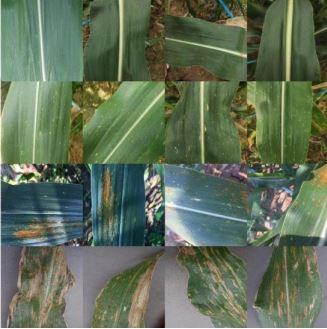Enhancing Maize Disease Detection: A Comprehensive Study on Few-Shot Learning, Object Detection, and Synthetic Data Generation Using YOLOv5s-C3CBAM Model
Keywords:
Staple Crops, Disease Detection, Single Leaf Disorders, Unmanned Aerial Vehicles, Growth StagesAbstract
As the global population grows, ensuring food production, particularly of staple crops like maize, becomes crucial. Maize faces challenges from diseases impacting both yield and quality, threatening global food security. Traditional disease detection methods are inefficient, prompting a shift towards computer vision and machine learning. However, data scarcity hinders model training. This study explores few-shot learning to address this issue. In the context of maize in China, leaf diseases pose a significant threat, causing substantial economic losses. Current research focuses on single-leaf disorders, emphasizing the need for advanced detection algorithms, especially for complex diseases. Additionally, accurate plant counting during growth stages is vital for effective management, with computer vision-based approaches offering promising solutions, especially with Unmanned Aerial Vehicles (UAVs). Object detection technology, employing both one-stage and two-stage methods, plays a pivotal role in agricultural research. YOLOv5s emerges as an efficient model, demonstrating success in various applications, including disease detection and plant counting. The study introduces a comprehensive methodology involving dataset expansion, Cycle GAN for synthetic data, and the YOLOv5s-C3CBAM model for maize disease detection. Results indicate the superiority of the YOLOv5s-C3CBAM model, with improvements in mean average precision (mAP), recall, F1 score, and precision. The study delves into model comparisons, experimental parameters, and disease identification accuracy. The YOLOv5s-C3CBAM model achieves 83% mAP_0.5, outperforming other models. Limitations, such as focusing on three diseases, are acknowledged, and future directions involve building a more comprehensive dataset. The study introduces innovations in image generation using Cycle GAN and attention processes, addressing challenges in disease detection accuracy. Despite limitations, the YOLOv5s-C3CBAM model contributes to accurate crop disease diagnosis, serving as a reference for future agricultural research.
References
Y. Zhang, S. Wa, Y. Liu, X. Zhou, P. Sun, and Q. Ma, “High-accuracy detection of maize leaf diseases cnn based on multi-pathway activation function module,” Remote Sens., vol. 13, no. 21, Nov. 2021, doi: 10.3390/RS13214218.
Y. Zhang, H. Wang, R. Xu, X. Yang, Y. Wang, and Y. Liu, “High-Precision Seedling Detection Model Based on Multi-Activation Layer and Depth-Separable Convolution Using Images Acquired by Drones,” Drones, vol. 6, no. 6, Jun. 2022, doi: 10.3390/DRONES6060152.
Z. Hui, J. Li, X. Wang, and X. Gao, “Image Fine-grained Inpainting,” Feb. 2020, Accessed: Oct. 01, 2023. [Online]. Available: https://arxiv.org/abs/2002.02609v2
W. Chen, B. Qi, X. Liu, H. Li, X. Hao, and Y. Peng, “Temperature-Robust Learned Image Recovery for Shallow-Designed Imaging Systems,” Adv. Intell. Syst., vol. 4, no. 10, p. 2200149, Oct. 2022, doi: 10.1002/AISY.202200149.
“High-Accuracy Maize Disease Detection Based on Attention Generative Adversarial Network and Few-Shot Learning - PMC.” Accessed: Feb. 17, 2024. [Online]. Available: https://www.ncbi.nlm.nih.gov/pmc/articles/PMC10490187/
Q. Xie et al., “Crop height estimation of corn from multi-year radarsat-2 polarimetric observables using machine learning,” Remote Sens., vol. 13, no. 3, pp. 1–19, Feb. 2021, doi: 10.3390/RS13030392.
H. Lee, J. Wang, and B. Leblon, “Using linear regression, random forests, and support vector machine with unmanned aerial vehicle multispectral images to predict canopy nitrogen weight in corn,” Remote Sens., vol. 12, no. 13, Jul. 2020, doi: 10.3390/RS12132071.
J. Yu, J. Wang, and B. Leblon, “Evaluation of soil properties, topographic metrics, plant height, and unmanned aerial vehicle multispectral imagery using machine learning methods to estimate canopy nitrogen weight in corn,” Remote Sens., vol. 13, no. 16, Aug. 2021, doi: 10.3390/RS13163105.
Y. Zhang, S. Wa, L. Zhang, and C. Lv, “Automatic Plant Disease Detection Based on Tranvolution Detection Network With GAN Modules Using Leaf Images,” Front. Plant Sci., vol. 13, May 2022, doi: 10.3389/FPLS.2022.875693.
Y. Zhang, M. Li, X. Ma, X. Wu, and Y. Wang, “High-Precision Wheat Head Detection Model Based on One-Stage Network and GAN Model,” Front. Plant Sci., vol. 13, Jun. 2022, doi: 10.3389/FPLS.2022.787852.
J. Gui, Z. Sun, Y. Wen, D. Tao, and J. Ye, “A Review on Generative Adversarial Networks: Algorithms, Theory, and Applications,” IEEE Trans. Knowl. Data Eng., vol. 35, no. 4, pp. 3313–3332, Apr. 2023, doi: 10.1109/TKDE.2021.3130191.
H. Guo et al., “Sample Expansion and Classification Model of Maize Leaf Diseases Based on the Self-Attention CycleGAN,” Sustain., vol. 15, no. 18, Sep. 2023, doi: 10.3390/SU151813420.
Y. Wang, J. Wu, P. Lan, F. Li, C. Ge, and F. Sun, “Apple disease identification using improved Faster R-CNN,” J. For. Eng., vol. 7, no. 1, pp. 153–159, Jan. 2022, doi: 10.13360/J.ISSN.2096-1359.202104028.
L. Huang, Z. Zhou, Y. Guo, and Y. Wang, “A stability-enhanced CycleGAN for effective domain transformation of unpaired ultrasound images,” Biomed. Signal Process. Control, vol. 77, Aug. 2022, doi: 10.1016/J.BSPC.2022.103831.
E. T. A. Albert, N. H. Bille, and N. M. E. Leonard, “Improvement of plant disease classification accuracy with generative model-synthesized training datasets,” Res. Biotechnol., pp. 1–11, Feb. 2023, doi: 10.25081/RIB.2023.V14.8214.
P. Dong, K. Li, M. Wang, F. Li, W. Guo, and H. Si, “Maize Leaf Compound Disease Recognition Based on Attention Mechanism,” Agric. 2024, Vol. 14, Page 74, vol. 14, no. 1, p. 74, Dec. 2023, doi: 10.3390/AGRICULTURE14010074.
“View of Evaluating Spatio-Temporal Decline to Agriculture through Satellite Imagery from 2010-2022.” Accessed: Feb. 22, 2024. [Online]. Available: https://journal.50sea.com/index.php/IJASD/article/view/471/971
Y. Song et al., “High-Accuracy Maize Disease Detection Based on Attention Generative Adversarial Network and Few-Shot Learning,” Plants, vol. 12, no. 17, Sep. 2023, doi: 10.3390/PLANTS12173105.
W. Xu, W. Li, L. Wang, and M. F. Pompelli, “Enhancing Corn Pest and Disease Recognition through Deep Learning: A Comprehensive Analysis,” Agronomy, vol. 13, no. 9, Sep. 2023, doi: 10.3390/AGRONOMY13092242.
D. Theckedath and R. R. Sedamkar, “Detecting Affect States Using VGG16, ResNet50 and SE-ResNet50 Networks,” SN Comput. Sci., vol. 1, no. 2, Mar. 2020, doi: 10.1007/S42979-020-0114-9.
J. Hu, L. Shen, S. Albanie, G. Sun, and E. Wu, “Squeeze-and-Excitation Networks,” IEEE Trans. Pattern Anal. Mach. Intell., vol. 42, no. 8, pp. 2011–2023, Aug. 2020, doi: 10.1109/TPAMI.2019.2913372.
F. Rajeena P. P, A. S. U, M. A. Moustafa, and M. A. S. Ali, “Detecting Plant Disease in Corn Leaf Using EfficientNet Architecture—An Analytical Approach,” Electron., vol. 12, no. 8, Apr. 2023, doi: 10.3390/ELECTRONICS12081938.
W. Ding and L. Zhang, “Building Detection in Remote Sensing Image Based on Improved YOLOV5,” Proc. - 2021 17th Int. Conf. Comput. Intell. Secur. CIS 2021, pp. 133–136, 2021, doi: 10.1109/CIS54983.2021.00036.
S. Woo, J. Park, J. Y. Lee, and I. S. Kweon, “CBAM: Convolutional block attention module,” Lect. Notes Comput. Sci. (including Subser. Lect. Notes Artif. Intell. Lect. Notes Bioinformatics), vol. 11211 LNCS, pp. 3–19, 2018, doi: 10.1007/978-3-030-01234-2_1.
H. Wang, J. Feng, and H. Yin, “Improved Method for Apple Fruit Target Detection Based on YOLOv5s,” Agric., vol. 13, no. 11, Nov. 2023, doi: 10.3390/AGRICULTURE13112167.
“Agriculture | Free Full-Text | Maize Leaf Compound Disease Recognition Based on Attention Mechanism.” Accessed: Feb. 17, 2024. [Online]. Available: https://www.mdpi.com/2077-0472/14/1/74
S. P. Mohanty, D. P. Hughes, and M. Salathé, “Using deep learning for image-based plant disease detection,” Front. Plant Sci., vol. 7, no. September, p. 1419, Sep. 2016, doi: 10.3389/FPLS.2016.01419/BIBTEX.
Y. Hu, G. Liu, Z. Chen, J. Liu, and J. Guo, “Lightweight One-Stage Maize Leaf Disease Detection Model with Knowledge Distillation,” Agric., vol. 13, no. 9, Sep. 2023, doi: 10.3390/AGRICULTURE13091664.
W. Bao, X. Huang, G. Hu, and D. Liang, “Identification of maize leaf diseases using improved convolutional neural network,” Nongye Gongcheng Xuebao/Transactions Chinese Soc. Agric. Eng., vol. 37, no. 6, pp. 160–167, Mar. 2021, doi: 10.11975/J.ISSN.1002-6819.2021.06.020.
Y. Qiao et al., “A Counting Method of Red Jujube Based on Improved YOLOv5s,” Agric., vol. 12, no. 12, Dec. 2022, doi: 10.3390/AGRICULTURE12122071.
S. Ghaffarian, J. Valente, M. Van Der Voort, and B. Tekinerdogan, “Effect of Attention Mechanism in Deep Learning-Based Remote Sensing Image Processing: A Systematic Literature Review,” Remote Sens. 2021, Vol. 13, Page 2965, vol. 13, no. 15, p. 2965, Jul. 2021, doi: 10.3390/RS13152965.
Z. Li, W. Tao, J. Liu, F. Zhu, G. Du, and G. Ji, “Tomato Leaf Disease Recognition via Optimizing Deep Learning Methods Considering Global Pixel Value Distribution,” Horticulturae, vol. 9, no. 9, Sep. 2023, doi: 10.3390/HORTICULTURAE9091034.




